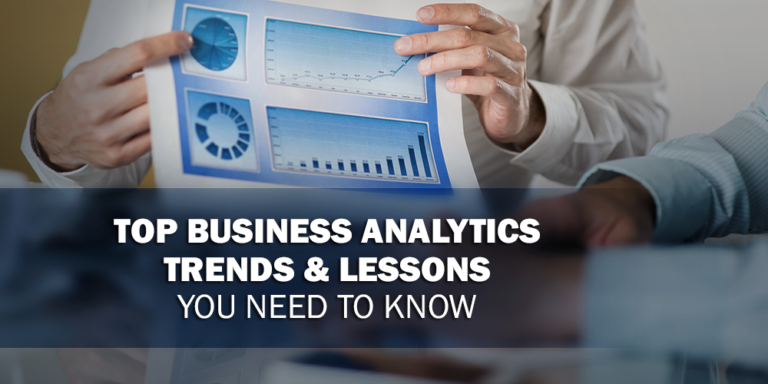Knowledge is power. And in business, data is power. Across all industries, data enables businesses to make important decisions that push them forward.
The whole process of tracking and interpreting data is called business analytics. It fuses technology, business experience, skills, applications and general business practices to analyze past performances across all levels. However, it is more of a “process” rather than a “science.”
Many companies use business analytics to pinpoint their current state of health. Businesses also use existing data as a reference for future decisions and course. What companies do with business analytics is entirely up to them, however, when used properly, it can equip employees with data-driven decision-making skills that promote bigger growth.
There are four key components of business analytics, namely analytics, data management, business intelligence and performance management. Let’s define each component.
Analytics: This refers to the mining of data and using logical analysis to discover meaningful patterns that can give businesses foresight into possible business trends.
Data Management: This covers several aspects of the collected data such as who has access; how it can be accessed; and when and where it can be accessed. Some data can only be accessed by managers and up while some data can be accessed by all members of the organization.
Business Intelligence: This component uses dashboards and reporting tool to understand questions about an event. While business intelligence (BI) and business analytics (BA) are sometimes interchangeable, there are several differences.
BA includes data mining and statistical analysis while BI includes reporting of key performance indicators (KPIs), automated alerts, dashboards and scorecards among others. BA answers the questions “Why did it happen?” and “Will it happen again?” BI respectively answers “What happened?” and “When will it happen again?”
Performance Management: This covers the steps taken and tools used to monitor and manage how the business is performing. This can include financial reports and budget forecasts to name a few.
What are the types of Business Analytics?
Now that we know the four components of business analytics, it’s time to tackle its three types:
Descriptive Analytics: This refers to the incoming data and what’s happening right now. Real-time dashboards or email reports are normally used to track and mine the incoming data whose sole purpose is to summarize the event. In a social media campaign, descriptive analytics refer to the number of likes, shares, page views, mentions, check-ins, posts, fans, followers and more.
Predictive Analytics: After gathering the data, you now use a series of statistical techniques, data mining practices, and models to make sense of the data you have on hand. This enables analysts to “read” and predict results or trends based on the current data.
“The purpose of predictive analytics is NOT to tell you what will happen in the future. It cannot do that. In fact, no analytics can do that. Predictive analytics can only forecast what might happen in the future, because all predictive analytics are probabilistic in nature,” wrote Lithium Technologies’ chief scientist Dr. Michael Wu in the company blog. Wu stressed that predictive analytics will not predict a single possible scenario. It can, however, predict multiple futures based on the next actions taken.
Prescriptive Analytics: Believed to be the most valuable kind of data, this one helps show businesses what to do next by suggesting decision options and showing each option’s possible implications. In action, this analytics often lead to recommended next steps and rules.
Top Business Analytic Trends and Learnings
Cloud-based data management increases. More and more organizations will embrace cloud-based data warehousing. This will enable businesses to improve data access without the overhead cost compared to the conventional on-site management.
Internet of Things (IoT)-based product tracking. Gartner Inc. is a global leader in information technology research and advisory company. In a Forbes article, Gartner claimed that the fast distribution of the IoT will give birth to a new method of product tracking wherein less expensive sensors will be embedded into various products.
These sensors will feed data on where the product is right currently and also track its performance data. For example, if you own a vehicle with an embedded sensor, the company can track its current location and if it’s due for an oil change. This method offers many opportunities for customer transparency and satisfaction.
Rich media analytics gets more complicated. In the world of digital advertising, rich media refers to an online advertisement with highly advanced features such as video and audio. Unlike static banner ads, rich media encourages interaction from the viewer.
The International Data Corporation (IDC) predicted that the analytics for rich media will further rise as a key driver towards big data and analytics investment. To achieve this, rich media will be given more advanced analytics tools.
Television Broadcasts Ltd. (TVB) in Hong Kong was founded in 1967. It is also the country’s pioneer wireless commercial TV station that offers 24/7 news services and entertainment channels. To adapt to the growing digital media age, TVB launched web service myTV along with an accompanying mobile app and the view-on-demand GOTV.
The company used cloud-based social media analytics to gain better understanding of their viewers’ behaviors and preferences. They used the data collected from posted comments across various social media platforms to improve their programming and campaigns. The company was able to gather over 30 years’ worth of program ratings to better understand media consumption trends in the past years.
Predictive analytics will help drive efficiency. More and more applications that make use of predictive tools are popping up. Harnessing the powers of predictive analytics will not only help businesses improve their efficiency but also create a vigorous and adaptive organization.
Big data, simplified. The need to translate big data into a straightforward context is increasing across all levels, including consumption, technical and social applications. As the need for big data experts increases, more people will also invest in big data knowledge.
Staying ahead will always be the name of game and in this age, big data is a hot player. Check out the available APEX course for business analytics certification and use the power of big data to make a big difference in your organization.



